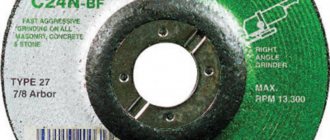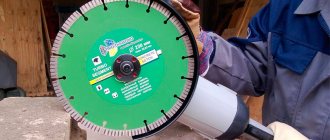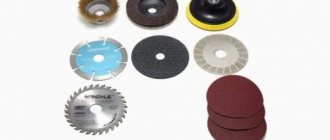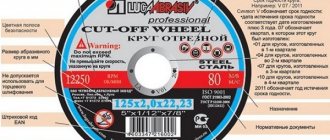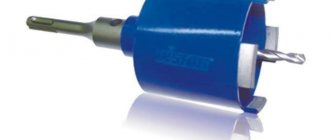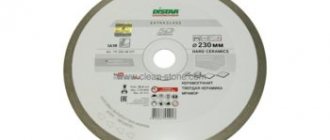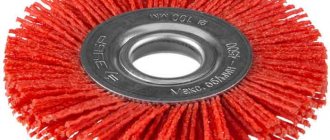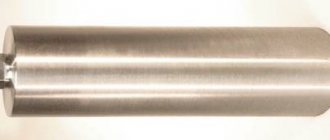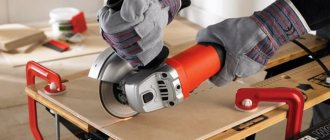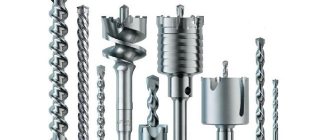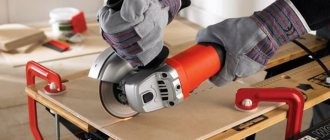The grinder is a universal tool with a wide range of capabilities. To implement them, a special attachment for the grinder is required. Among its types is a diamond cup for concrete for a grinder, which is used to clean and polish floors and walls.
Types of Diamond Cups
Cups are divided into several types, each of which performs a different grinding task. The classification is based on the shape and number of cutters. Disc types:
- The grinding segments are arranged in one row. This product has a relatively low weight, but quite high performance. The downside is that it is very difficult to keep it in the required area.
- The cutters are arranged in two rows. These products are very often used for roughing. The placement of cutting elements allows you to very quickly deal with absolutely any defects not only on concrete, but also on natural stone, as well as sandstone. This type of cup only performs rough processing. For final finishing you will have to use a different nozzle.
- "Square". This disc is quite heavy. It is also needed for rough processing. During the process, in addition to grinding, chipping also occurs. This allows you to significantly speed up work and reduce wear on the product. In almost all cases, such a cup is used for preparatory work, after which some kind of polymer composition will be applied to the concrete. This is a very rough sanding product that leaves a rough surface.
- "Typhoon". Designed for finishing work on very hard and dense materials. This bowl wears out for quite a long time, which provides long service life. The surface of the disk itself has a special shape, thanks to which particles are removed efficiently.
- "Turbo". On the surface of the disk, the cutters are located almost in one row. This allows for very precise sanding. This attachment is used in cases where high surface quality is required. It can be used to create chamfers and edges on various types of tiles. Even engravers and stonemasons use the cup. This type also has a very high degree of wear resistance.
- "Boomerang". Intended for finishing work, when the material must be handled with extreme care. Diamond inclusions are small in size, which makes it possible to perform delicate processing.
Features of work
This type of work has its own specific nuances. To increase the grinding efficiency, as well as the performance of diamond blades, it is advisable to follow the recommendations given by professionals. Basic Rules:
- Preparatory work is carried out with a manual machine. It is advisable to treat the edge before sanding. This will significantly reduce the load on the tool and remove all irregularities.
- Peeling should be done using different devices. This is determined by the type of material. Of course, it is best to remove a layer of reinforced concrete with diamond cups, but for softer surfaces it is advisable to use an abrasive tool.
- It is necessary to ensure that the circle does not come into contact with the sharp edges of the building material.
- Experts say that cracked walls and ceilings should not be treated.
- The maximum water pressure should be 2.5 atm.
- Do not press the cutter against the materials with great force.
- The grinder needs to be held as tightly as possible, this will allow you not to overload the cup. Otherwise, the service life will be significantly reduced.
- If the power supply is unstable, then working with ground diamond blades is prohibited.
READ Making your own concrete mixer from a barrel
Following these recommendations will help create the maximum degree of safety in the workplace and significantly increase the life of the tool.
Repairing Potholes
Quite often, during repair work, potholes have to be fixed. If the concrete coating has been in use for quite a long time, then most often you can find various bumps and dents on its surface. The maximum permissible difference is 5 mm. If this value is exceeded, it is necessary to remove defects before grinding:
- The damaged area is cut out with a regular diamond wheel. The minimum depth should be 20 mm. After the cuts, the material is removed with a chisel or hammer drill.
- The resulting cavity is cleared of dust.
- The entire surface is treated with a primer.
- The wall is plastered or covered with another special compound.
- Using the rule, the surface is leveled.
READ Diamond grinding cup for concrete for angle grinders
After the solution has completely hardened, grinding is done with a special wheel. Small cracks can often simply be cut away. All work is done in exactly the same way, but there is no need to knock out the damaged area.
Leveling process
Sanding will not correct all the mistakes made during the preliminary stages of work. With its help you can only remove a thin layer of concrete and also level the wall.
While performing this procedure, you need to remember safety precautions. You should at least wear special safety glasses.
The work is carried out according to the following instructions:
- You can turn on the grinder only if it has been tested for functionality.
- The fastening of the grinding wheel is checked. The bowl should be screwed on as securely as possible.
- You can work for no more than 15 minutes. The equipment must then be turned off to allow it to cool to ambient temperature.
- It is advisable to wear a special suit that can protect against dust.
- For a high quality final result, bowls should be changed on time. Such products wear out quite quickly.
When processing screed, it is best to use bowls with a minimum grain size of 400. This will allow you to achieve the best result.
Wall treatment
When working with walls, you need to remember certain nuances. They cannot be processed with the same equipment that is used for flooring. When cleaning walls you should:
- Use hand-held sanders equipped with coarse-grit attachments.
- It is advisable to start from a corner.
- Sanding is best done in several strips. You should move from the ceiling to the floor.
- At regular intervals you need to check using a level.
- If the walls were covered with putty, then it is better not to put too much pressure on the tool. This may result in the entire layer being removed.
When a special concrete bowl is used to finish concrete surfaces, the texture and overall appearance become better.
In addition, this allows you to smooth out small differences. The walls will not only become more beautiful, but will also have higher performance characteristics. Special diamond discs designed for concrete processing are modern and very high-quality equipment. It greatly simplifies finishing work. Different types of these products are intended for different concrete structures.
Now on the market you can find many special devices that are designed specifically for processing concrete. The main advantage of diamond bowls is their very high efficiency rates. With their help, basic work can be completed in a minimum amount of time. That's why they have become so popular among professionals and home craftsmen.
Advantages and applications of polished concrete floors
Treated concrete floors have gained great popularity among finishing coatings not only in the public but also in the private category. It is mainly used:
- in medical and educational institutions;
- in shopping and sports centers;
- in water parks;
- in entertainment establishments;
- at cultural venues;
- in suburban areas;
- as a floor covering in outbuildings and garages;
- Increasingly, polished concrete floors can be found in dressing rooms and corridors in the homes of ordinary citizens.
It has earned such a wide range of applications due to its performance characteristics, which in many ways exceed the advantages of even the highest quality finishing coatings:
- the service life is estimated at decades, which is ensured not only by its increased strength characteristics, but also by its resistance to moisture saturation. An ordinary concrete screed without a finishing coating or treatment does not have such significant advantages;
- the floor sanded to a gloss is similar to elite self-leveling coatings;
- affordable cost;
- is an ideal basis when a perfectly flat base for a decorative coating is required;
- does not produce harmful dust during operation;
- grinding makes it possible to level substrates even with strong relief;
- does not require periodic repairs. If such a need arises, then making a “patch” will not be difficult.
In order for the topcoat to retain these properties for as long as possible, the poured concrete floor must be properly sanded. If the filling is old, not only the decorative layer, but also the main layer is polished. If a new concrete floor is installed, laitance will need to be removed. Also, grinding concrete surfaces with special tools is an integral part of preparing the base for self-leveling floors.
Be careful and do not fall for the common misconception - grinding does not solve the problems of adjusting the relief surface. Leveling is carried out at the stage of primary pouring or re-driving of the concrete layer.
Flexible circles
The turtle is an elastic circle on which a layer of diamond powder and an adhesive polymer mixture is applied. The unique feature of this type of grinding wheel is that it can be used to process surfaces in hard-to-reach places. The flexible wheel for an angle grinder has high productivity and cutting ability that exceeds the similar characteristics of a conventional cutting disc by several times.
The turtle is used not only for processing building materials. It is used to polish granite, marble, precious stones and glass. If ordinary cutting wheels for grinders cannot be used for industrial devices, since they may not fit in size, then with a flexible disk the situation is completely different.
Modern industry is able to offer any working circles for power tools. All that remains is to choose the one suitable for the material being processed. You can opt for universal diamond wheels for an angle grinder, but you just need to take into account the amount of work ahead. Or maybe you should immediately buy both a flexible disk and a diamond cup to do everything quickly and efficiently.
How to choose a diamond cup
To produce high-quality processing of a stone or concrete surface, you should carefully consider the choice of a diamond cup. Depending on the type of planned work, the diameter of the nozzle is selected - from 110 to 180 mm. To process small areas where careful sanding is necessary, you need to choose a small cup size. The greatest demand is for 125 mm concrete discs. There are nozzles with a diameter of more than 200 mm. Processing concrete with the help of such a cup is much faster. However, it should be remembered that as the diameter increases, the price also increases.
In accordance with GOST, the diameter of the mounting hole varies from 19 to 22.2 mm. The mounting hole must match the tool that is intended to be used. A loose cup fit can lead to injury and rapid wear of the diamond layer. But usually the attachment kit includes an adapter ring that allows you to use them with tools of different diameters.
All diamond grinding discs for concrete have special markings. It reflects the main characteristics in the following sequence:
- diameter of the outer circle (for example, 125);
- cup depth (40);
- working surface width (10);
- segment height (3);
- mounting hole (22).
All parameters are indicated in millimeters. The brand of diamond powder and the diamond content are specified separately. As a rule, it is 100%, but it can be less or more
Particular attention should be paid to the grain size (for example, 125/100 µm). Large fractions are suitable for rough grinding and roughing work, small fractions are suitable for fine polishing
The nozzle is selected to match the existing tool. The maximum permissible rotation speed of the disk must correspond to that of an angle grinder, since the safety of work depends on this. Each type of diamond cup has rotation speed restrictions. For example, for double-row cups it is 13,300 rpm.
The weight of the attachment and its balance are also important parameters when choosing a tool. The speed and comfort during surface treatment depends on this.
Nozzle for an angle grinder. Types of Diamond Cups
Attachments for grinding concrete using an angle grinder are classified depending on the manufacturing method.
There are types:
- with a single-row working surface;
- double row;
- solid.
Single-row equipment has good performance and low weight. It is used to polish concrete and create a smooth edge. The disadvantage is that the tool is difficult to hold on the surface.
Double-row cups are used to carry out primary processing and eliminate gross defects in the concrete screed. Surfaces are polished using nozzles with continuous coating.
Varieties
Based on the shape and number of diamond segments, cups are divided into several types, each of which is designed to work under certain conditions. Depending on this, the scope and purpose of the instrument changes.
The double-segment diamond cup is excellent for roughing sandstone, natural stone and concrete surfaces. The special profile allows the master to eliminate all defects in the material as efficiently and quickly as possible. The tool performs rough surface treatment, so to achieve a better result it is necessary to use a different attachment.
A cup with segments in one row has greater productivity and less weight, but it is noticeably more difficult to hold on the surface.
The segmented “Turbo” model is made in the form of a continuous row of diamond inclusions, which ensures the most accurate grinding of the working surface. It makes sense to use this attachment if you need to obtain the highest quality sanded surface. Using it, you can easily create edges and chamfers from granite and marble slabs. “Turbo” is often used by stone engravers when working on stone monuments. In addition, the attachment makes it relatively easy to create various bends on the surfaces of stone slabs. For more precise processing of stone surfaces, special diamond bits with a diameter of about 100 millimeters are sold in specialized stores. They are often used by professional craftsmen. In addition to increased accuracy, such models are distinguished by a long service life.
Model "Boomerang"
When doing finishing work, it is important for craftsmen to handle the material being processed as carefully as possible. For this purpose, a “Boomerang” diamond cup is usually used, the small diamond inclusions of which ensure the most delicate processing.
This attachment is especially popular among craftsmen, as it provides a softer and more stable stroke than double-row cutters, while not being inferior to them in terms of productivity.
Typhoon nozzles. Allows grinding and roughing work with hard and super-dense materials. With low weight they have a long service life and high wear resistance. And thanks to the special shape of the disc, the most effective removal of particles of ground material is achieved.
Diamond cup "Square". Standing out for its large mass, it is intended for coarser grinding. During operation, in addition to conventional grinding, the attachment provides the effect of chipping the material, which significantly reduces tool wear and increases the speed of work. Typically, the “Square” nozzle is used by craftsmen to process material before directly coating the surface with polymers. It is considered a rather rough cup, after which the surface is more rough, which in turn increases adhesion to other materials.
Tool selection
When purchasing a circle for an angle grinder, many factors are taken into account that determine the final choice. Each individual case requires an individual approach. The main conditions on which the characteristics and optimal dimensions depend are:
- Material. Most often, ordinary concrete is processed with segment tools for dry cutting. The new concrete surface has a high level of abrasiveness. This causes rapid wear of the discs. For such work, it is better to purchase thicker discs. Old concrete is stronger than young concrete, so it is better to use options of moderate thickness. If the cement-sand mixture includes quartz sand or balsate, then the abrasiveness of the concrete goes off scale. It is better to choose options where diamond plates are soldered with silver to the base. If you need to cut reinforced concrete, granite or concrete, then a soft diamond wheel is used.
- Cutting method. Wet technology allows cutting reinforced concrete and concrete accurately and quickly, avoiding dust and overheating of the tool. But before purchasing solid discs, you need to make sure that the cutting equipment has a cooling system. For dry cutting, buy segmented circles.
- Working conditions. For home use, products with the optimal ratio of quality and price are selected. They will be able to cope with reinforced concrete and medium-reinforced concrete. If you use them periodically and avoid overloading, they will last quite a long time. Professional discs are designed for continuous use. They have increased durability and wear resistance. Distal and Bosch companies produce the best samples. Such products must be purchased strictly for their intended purpose: concrete cannot be cut with a disk on marble.
- Equipment and cutting depth. The deeper you need to make the cut, the larger the diameter of the circle should be. At the same time, you should not forget about the capabilities of the device. If you attach a disk that is too large, its linear speed will be very high, which will lead to rapid wear. And if you put on a small one, the car will heat up and slip. For powerful wall saws, diamond circular saws are produced, the outer diameter of which should not exceed 1200 millimeters. To work with large-sized foundation blocks and concrete elements, machines with a working diameter of 350-400 millimeters are needed.
Circles for hand-held power tools have more modest dimensions.
For cutting concrete when renovating a room, products with a diameter of 115-120 millimeters are used. To process lintels in openings, slopes and other elements, grinder discs for reinforced concrete and concrete are used, the diameter of which is 150-230 millimeters. The wall chaser works in the same way as the grinder. But the concrete is grooved with two diamond wheels. The width and depth of the cut are adjustable during operation. The diameter is selected depending on the depth of the groove. It ranges from 110-365 millimeters. Grooves for any communications can be made using dry technology, efficiently and quickly, using a powerful wall chaser and diamond wheels for reinforced concrete.
Surface preparation
Remove old coverings from the floor. Achieve as smooth a surface as possible before using an angle grinder.
Attention! If there are a large number of potholes and holes, then increase the density of the fillers.
Inspect the floor for cracks in expansion joints. If there are any, then seal and sand the problem areas. Before using the tool, check the strength of the coating on a small area.
You should know the design of the coating. If there is metal reinforcement in the top layer, then remove it with a grinder, cutting it off with a regular disk.
Principles of work performance
Each type of concrete has its own characteristics, so work always begins with an accurate determination of its characteristics. As a rule, experienced craftsmen choose special discs for plain and reinforced concrete, for fresh and old. Even inclusions in the form of basalt or quartz can tell you which disk is best if you have enough experience to understand such clues.
If possible, cutting concrete should be done wet. A thin layer of water cools the cutting wheel and tool, which extends the service life of the latter and ensures continuous operation. If there is no water nearby or there is not enough of it, cutting is done dry, but in this case you cannot rush - the work is usually carried out in several stages, allowing the unit to cool a little after each approach. To make sure that the tool and disk successfully cope with the task, the first cut is completely limited to a depth of 1 cm, after which the grinder and disk are carefully inspected for possible mechanical damage.
The sawing procedure itself is quite simple. Even with wet cutting, care should be taken to ensure respiratory protection in case something goes wrong. After this, you should clearly outline the line of the future cut, and stands on both sides, made of wooden blocks, will also help you not to go deeper into the thickness of the material than it should be during the first cut. The first incision, as already mentioned, is usually made to a depth of no more than a centimeter. When cutting wet, you should spray water onto the blade as carefully as possible; there should not be too much of it, otherwise, if it gets into the angle grinder motor, it can cause damage to the electrical unit.
When the first cut is made and the cutting disc has cooled a little, the wooden stands are removed - now you can navigate without them, using the existing cut. When cutting to a significant depth, it is advisable to break the work into several stages.
Even without knowing the exact structure of a particular concrete product, you can be sure that when going deeper into the thickness by more than 10 centimeters, the probability of encountering metal reinforcement there is almost 100%, so choose the appropriate disc.
Work as an angle grinder
From the nozzle cup, the dust goes to special dust collection equipment.
Before starting sanding, wait about two weeks for the screed to dry if you are processing a new coating. This time is necessary for the floor to gain strength. The floor contains reinforcing fillers of crushed stone, gravel and other granules, which can be torn out by the disc if they are not firmly bonded in the mortar.
After the preparatory work on the old concrete surface is completed, grinding begins. Here are recommendations for completing the stage technologically and with a high-quality finish.
- Treat the surface with a special compound that will enter into a chemical reaction with calcium in the concrete. As a result, astringents will appear on the coating, which will hide the pores. This will increase strength and moisture resistance.
- If you use discs with a grit of more than 400, the surface will be quite durable. This floor will withstand intense loads. To obtain a smooth surface with a characteristic shine, diamond discs with a higher density are used.
- An angle grinder is needed in corners and hard-to-reach places.
Special attachment for equipment that allows processing areas near walls
- To prevent concrete particles from scattering all over the place, use a special cover for grinding concrete, which will allow you to collect the waste material in a garbage bag.
It is not necessary to buy a special casing for the grinder for grinding. You can make a cover for a cup with your own hands:
When the diamond blade processing is complete, the skirting boards are installed and the final stage is carried out. To add gloss to the surface, polyurethane polishing is used. Apply with a brush or roller. But before that, clean the surface from dust. Apply varnish in several layers.
Due to the long-term use of concrete floors, cracks and various types of defects may appear on them. If such areas are detected, carry out repair work in a timely manner.
Here are some tips for eliminating local defects of various types:
- potholes. Cut with a diamond disc to a depth of 2 cm. Remove the damaged cut area, clean the cavity from dust and treat with a primer. A solution (preferably non-shrinkable) is poured into the cavity and leveled using the rule. The hardened section of the repaired floor is sanded.
- crack. A thin crack is increased in thickness with a diamond blade. After this, the work is identical to pothole repair.
Grinding concrete with a grinder can add strength and increase moisture resistance. It is easier to use impregnations over smooth coatings to strengthen and increase adhesion.
Definition
Diamond cups are discs with cutters that are located on one side of the product. The mount is located on the back of the tool. There are a lot of diamond chips fixed in the equipment.
Builders use a cup with a diameter of 230 millimeters for polished concrete surfaces, since the tool can withstand heavy loads. Diamond cup 125 is a durable metal disc with diamonds embedded in its base. The diameter of such discs is 100-230 millimeters, but most often specialists use a diamond cup with a diameter of 125 millimeters. The discs are installed on a manual grinding mechanism - an angle grinder
Scope of application
The high reliability and wear resistance of the diamond cup make it unrivaled among other equipment for processing hard materials. Using the nozzle, you can scrape and grind concrete, brickwork, stone slabs, porcelain tiles, and paving slabs. Diamond discs are widely used for polishing natural stone - marble or granite. Operations performed using discs include rough, profiled and finishing grinding operations. Diamond cups are used for the following purposes:
- removal of screed sagging;
- roughening;
- alignment of seams;
- grinding joints;
- surface cleaning;
- removal of old or protruding layer;
- final polishing.
When installing attachments on an angle grinder, a dust extractor is usually used or the surface to be treated is moistened with water (wet grinding). This will help reduce dust and make cleaning easier.
are widely used during dismantling work. They effectively remove layers of used glue, hard-to-remove coatings (epoxy, plaster, plaster) and have a long service life. Grinding with a diamond cup saves time: it not only removes unnecessary layers, but also immediately levels the surface.
Varieties
We recommend reading our other articles
- How to choose a project for a garden house?
- Time to plant tomatoes in the greenhouse
- The attractiveness of using quartz vinyl tiles in your own home
- Quality and practicality of modern laminate
Metal discs for concrete work are divided depending on the application into:
- The “double segment” is used for rough work on concrete, eliminating defects in the concrete surface and uneven screed layer.
- “Boomerang” is used when carrying out finishing work. Diamond blades “Boomerang” are used for delicate processing of materials; they are distinguished by their low weight, high productivity, and soft operation.
- “Dolphin” is a gentle tool, wear-resistant, productive, and light in weight.
- Square diamond cups are the heaviest and are used for rough processes. They level concrete and increase its adhesion to other materials, in particular polymers.
- “Turbo” and “Typhoon” are the latest developments among grinding profiles. They have high performance, wear resistance and are used for processing dense concrete and other dense materials.
Tools with the addition of diamonds are highly effective; they qualitatively prepare concrete surfaces for the next stages of work and finishing.
Main characteristics
Double-row bowls are considered more productive.
To make cups, a metal alloy and small fractions of diamonds are needed. This composition must be compressed in special forms. Since this grinding equipment is used for various purposes, it differs in several ways:
- type of binder;
- crumb size;
- location and type of cutters on the cup.
In addition, discs can be double-row or single-row. Double-row ones are considered more productive. They also have a long service life. At the same time, such discs are more expensive than other models.
With the help of a nozzle, builders are able to smooth out sagging and other defects that arise when molding a cement mixture. High-quality grinding allows you to make concrete walls smooth. This results in a perfectly polished surface. Cups are often used for various construction works. For example, when dismantling formwork from structures, nozzles are indispensable for leveling seams. However, they also have other advantages. Thus, they are used for the restoration of concrete products.
In addition, high-quality grinding discs weigh little, grind the surfaces of concrete structures well, allow you to restore old products, and are considered highly productive. With proper handling, the equipment will serve you for many years. Metal circles are produced with a diameter of 150-180 millimeters. Diamond equipment can be used both for grinding surfaces and for drilling concrete.
Design features
Crown for concrete: types of crowns and design features
Cups for concrete are made of hardened steel with fused small fractions of diamonds. The nozzle is a product consisting of the following elements:
- Round concave base with elements for installation on high-speed electric tools.
- A grinding wheel for concrete, on which segments with diamond fractions are fused.
The bowl-shaped base has holes for cooling during operation. Diamond cutters are located in a circle on the working circumference of the disk, separated by certain intervals (slots). The slots also help cool the cup with air and, in the case of wet processing, with water.
The diamond cup for grinding concrete is attached to the spindle of the grinder using a nut; for this purpose, there is a special hole in the center of the base. Some models have a thread, and the tool can simply be screwed onto the shaft.
Features of grinding work
Diamond, as the hardest substance, effectively copes with the most difficult jobs of cleaning and grinding concrete screeds. To perform surface treatment, a diamond alloy cup is attached to the spindle of an angle grinder (grinder). The rotational motion that is transmitted to the disk is approximately 11,000 revolutions per minute. The high power of the tool on which the diamond concrete grinding cup is mounted also increases the productivity of the disc itself.
When working with hard surfaces, consider the following guidelines:
- The correct choice of nozzle in accordance with its purpose will greatly facilitate the processing of concrete.
- Before finishing grinding, rough grinding of edges and sagging is carried out to reduce the load on the disc.
- To break in the cup, it is necessary to carefully break it in in a gentle mode during the first few meters.
- The grinder should be held firmly with both hands to prevent impacts, especially when removing rough protruding defects.
- During operation, the cutter is pressed against the surface, but without increased pressure.
- Do not grind surfaces with breaks or cracks.
- To self-clean the nozzle, effectively cool it and reduce dust formation, it is recommended to supply water to the screed being treated.
- It is strictly not recommended to carry out work during frequent power outages or using faulty tools.
To avoid injury during work, you should use closed shoes made of thick, durable material. Compliance with these simple recommendations will ensure safety during work and extend the life of the diamond cup for construction concrete for an angle grinder.
Product selection
It is possible to process concrete quickly and with a high level of quality only if the grinding cup is selected correctly. In addition to the performance indicators of the product, the disk must have the same landing parameters as those of the angle grinder used. The standard outer diameter is 125 mm, and the cross-section of the mounting hole is 23 mm.
READ How to choose the right electric concrete mixers for your dacha
When choosing a tool, you need to pay attention to the following indicators:
- Grinder power.
- Number of revolutions per minute. This value should not exceed the maximum permitted speed of the disk itself. A close ratio makes work safer.
- The presence of an adapter ring.
The rate of heat removal is not so important. But this indicator directly affects the life of the grinder.
When choosing a diamond attachment for a tool, you need to take into account some characteristics:
- The type of sanding that will be used. It can be dry or wet. This affects the service life of the product, as well as the final quality of the result.
- The hardness of the material to be processed.
- Height of segments. The higher this value, the faster the sanding occurs, but the result is a rougher layer. For finishing machining, it is necessary to use cups with a minimum cutter height.
- Disc diameter. Selected based on the characteristics of the tool and the amount of work.
The cost of the tool is also an important factor. Usually a high price corresponds to good quality. In an inexpensive disc, the diamonds may be bad.
Why are disks needed?
The attachments are used for roughing work and finishing grinding. The first process refers to surface leveling and removal of defects. The base becomes rough, which increases the level of adhesion.
Finish grinding means removing the weak top layer (milk) from the concrete base. The surface becomes not only attractive, but also more durable.
Types of nozzles
Due to the fact that grinding wheels solve problems of varying complexity, they are classified according to:
- Type of binding material.
- Size, number of diamonds.
- The appearance of the cutter and its location.
The main parameter is the shape of the segment and its location on the inside of the disk. The scope of application of the tool depends on this design feature.
Single-row and double-row disc
These nozzles differ from all others in their high level of performance. The cutters are located inside the bowl in 1 or 2 rows. Using the tool, they perform rough work on concrete, sandstone, and natural stone.
Due to the large diamond chips, it is possible to quickly remove all defects. Perfect for grinding screeds, cleaning the surface, leveling joints on concrete.
Disc with boomerang cutter
This disc gets its name from the shape of the segments. With its help they perform finishing work. This is due to the fact that less coarse diamond chips are applied to the circle.
Used for manual equipment. Using a circle, they form a perfectly even and smooth edge, remove irregularities, and clean the surface. This attachment is lighter than other cups. Because of this, it is easy to work with manual equipment.
Diamond cup typhoon
The appearance of the cutter resembles a corrugated surface. Characterized by high performance. Used for work on dense concrete, reinforced concrete, granite, and other hard materials. During operation, it is allowed to perform work both with and without water.
Features of choice
The quality and efficiency of work depends on the correct choice of diamond grinding cup. In order not to make a mistake in choosing a material, you need to consider the following points:
- For what purposes is a tool needed? A typhoon cup is suitable for roughing, and a double-row nozzle will eliminate defects and unevenness of the base.
- Circle size.
- Location of landing nests.
- The size of the mounting socket must correspond to the diameter of the shaft on the equipment.
- The rotation speed of the cup must match the maximum speed of the grinding equipment.
- The nozzle must be equipped with an adapter ring. It makes it possible to operate the tool on various equipment.
All of the above points are very important when choosing a tool, since productivity and the number of work cycles depend on them.
Recommendations for working with diamond cups
The effectiveness of the working tool and its service life depend on certain features during operation:
- Before using a new blade, cut concrete with this attachment.
- During work, the cup should not touch the sharp edge of the material being processed.
- Run in the disc. Operate the circle gently for the first 10 m.
- To avoid shock loads on the wheel, hold the equipment firmly in your hands.
- Do not apply excessive pressure to the cutter.
Nozzle in the form of grinding cups. Features of choice
Grinder discs for concrete: features and types
When choosing a tool, consider:
- Type of planned work. For each operation, special attachments are most effective. Using the wrong ones slows down the work or makes the process impossible, and quality suffers.
- The diameter of the cup, which should correspond to the power of the grinder. For accurate sanding of small areas, small attachments are more suitable. It is faster to work with large equipment, but its price is higher.
- Mounting hole, which must correspond to the size of the shaft. If the tool spindle is thinner, an O-ring is used: the fit on the shaft cannot be loose.
- The discs are designed for a rotation speed that the grinder cannot exceed.
The diamond grinding tool is marked with a marking that reflects:
- external diameter;
- cup depth;
- working edge width;
- segment height;
- mounting hole size.
Numbers in millimeters indicate characteristics in the sequence given above. The spraying parameters are indicated separately: diamond content in percentage, grain size in micrometers (µm). Coarse diamond powder is suitable for roughing and rough grinding; fine diamond powder is used for polishing.
Attachments and discs for concrete for grinders
Each tool used in conjunction with an angle grinder (angle grinder) is designed to perform the operations for which it is designed. The correct choice contributes to efficient and safe work with discs and attachments.
Cutting discs
Diamond cutting wheels are used to work with concrete. These are discs made of durable hardened steel with diamond coating on the cutting part.
These nozzles differ in the following design features:
- Cutting edge. It can be solid or with various slots. Segmentation increases the efficiency of air cooling during operation.
- The grain size of the diamond coating and the spraying method. The most reliable methods using laser welding and thermal bonding. Silver soldering allows operation with water cooling only. The electroplated diamond edge cuts only soft natural stones.
- The outer diameter of the circle. The correct size disks must be installed. Working without a protective cover is not only dangerous: the increased size of the nozzle leads to premature wear of the gearbox.
Diamond cutting can only cut material in a straight line. Curved sawing increases the load on the cutting edge, causing the diamonds to break.
Grinding discs for concrete
Concrete is ground to eliminate coating defects. Diamond wheels are used, which have a high abrasive ability and a long working life. Sometimes hard-alloy coated disks, the characteristics of which are lower, are called diamond. The efficiency of work is determined largely by the grain size of the working surface.
Depending on the concentration of diamonds, discs for grinding concrete are distinguished:
- with grain size 40-80 (for pre-treatment);
- with indicators 100-120 (for leveling the surface);
- with grit 180-240 (for polishing).
The tool is a steel circle with soldered segments. Diamond powder is fixed to them with a special bond. It keeps the diamonds from being destroyed by the centrifugal force that occurs during rotation.
The designations on the discs consist of 2 or 3 numbers. The first number indicates the outer diameter, the second indicates the size of the mounting hole. The third number is not always present; it indicates thickness. For a grinding tool, this parameter does not play a big role.
Cleaning and roughening attachments
These attachments look like cups or circles. There are cutters and diamond discs. Twisted metal brushes are located around the circumference of the rollers. They strip metal and stone. The diameter of the wire varies depending on the purpose (scraping or stripping).
Purpose of an angle grinder
The peculiarity of the machine is its ability to process not only smooth surfaces, but also chamfers. This is achieved thanks to the angular placement of the working disk.
The device is universal and can be used to perform many jobs:
- The main operation for which an angle grinder is intended is grinding. Wide grinding wheels are used. Processing the ends with an eccentric grinder is difficult, but it is accessible for an angle grinder. The surface is ground with or without water cooling.
- Polishing with a grinder is also possible. To do this, use special diamond-coated polishing discs.
- Another operation that is performed with a grinder is res. The unit is not suitable for working with thick materials. Concrete or thick stone should be cut with special machines that have a water-cooled working wheel.
- An angle grinder easily cleans surfaces, removing dirt, paint, mastics, adhesives, and construction mixtures using abrasive attachments.
A grinder can be used instead of a wall chaser. A cutting disc is used to cut grooves for electrical cables and pipelines.
Types of milling cutters for concrete
Diamond cutters are one of the types of cutting tools that are used to process concrete surfaces using special grinding machines. This tool can be in the form of a disk or an end, cylindrical, end, or key attachment. Mills for grinding concrete are a metal body onto which diamond segments are soldered.
The cutters can have an annular, trapezoidal and triangular shape. Each form is convenient and effective to use. The choice of cutter shape depends on the type of grinding machine.
The round diamond concrete cutter is used in CO type mosaic grinders for processing hard materials such as concrete, paving slabs, marble, etc. It is recommended to use coolant when grinding with this tool.
The triangular diamond concrete cutter is used for processing medium and hard abrasive surfaces . This tool is intended for completing CO type grinding machines. When working with it, cooling is also necessary.
A trapezoidal concrete cutter is also called “Frankfurt” . Such cutters are installed on GM type mosaic grinding machines and are used for grinding concrete, marble, granite, paving slabs, and hard refractories using cooling.
As you can see, diamond grinding tools can be made in different versions, which significantly expands the choice of necessary equipment depending on the requirements of the work being carried out.
Here is a video about diamond grinding discs for concrete:
When is concrete grinding needed?
Grinding a concrete wall
After applying concrete to the floor, an unstable layer forms on its top layer after hardening. From interaction with an external aggressive environment, exposure to mechanical loads, the surface can easily be destroyed.
To obtain a monolithic and durable concrete base, this collapsing layer must be cut off. Diamond cups for grinding concrete help to do this.
In addition, the use of such a diamond disc allows you to solve other problems:
- Grinding the dried concrete screed will make the surface smooth, it will become even, without minor flaws: dimples, tubercles, ripples;
- When grinding concrete that has been in use for a long time, it is possible to remove remnants of the old floor covering and traces of rather complex contaminants from its surface;
- After the process, the water resistance of the concrete surface increases several times;
- The level of dust formation is minimized;
- The strength and resistance of the surface to moisture, harmful chemicals, and temperature changes increases;
- The cost of maintaining the concrete base is reduced;
- A grinder and a diamond cup attached to it for grinding concrete allow you to give a nondescript concrete floor an attractive appearance.
Concrete grinding becomes an indispensable technological process after pouring the floor with self-leveling mixtures, applying various impregnating compounds or thin-layer paints. Grinding is used in commercial and administrative buildings, industrial buildings, and for arranging areas in front of buildings.
Tool characteristics
Diamond blades with a diameter of 125 and 230 mm are used for various types of concrete grinding.
She may be:
- Chernovaya;
- Profiled;
- Finish.
To make cups, a metal alloy and fine diamonds are used. This composition is compressed in special forms. The use of disks for different purposes determines their parameters.
They differ:
- Types of binder;
- Crumb size;
- Location and types of cutters on the cup.
In addition, discs can be: double-row, single-row. More reliable, durable and productive - double-row. But the price of such discs is higher than that of other models.
Types of tools
The peculiarity of using metal discs for grinding concrete, and the shape of the diamond segments of the grinding cup, determines their names.
From the table you can get acquainted with the types and features of the tool:
Cup Name Feature
"Double Segment"
Used for rough, rough grinding of concrete surfaces or sandstone. Often used to eliminate an uneven layer of thick screed.
"Boomerang"
Used for final grinding of surfaces. This is achieved by using a special fraction. The great popularity of disks is explained by their low weight and functional basis. This diamond grinding cup works softly and steadily on concrete, and the surface is as smooth as possible.
"Dolphin"
The dolphin nozzle is a gentle equipment that can be used to treat the surface very delicately. These are discs with low weight, high wear resistance and performance.
"Square"
The mass of such instruments is the largest. They are used for rough processing of concrete
At the same time, its excess is chipped off the surface, which increases the speed of construction work and increases the wear resistance of the nozzle. Treatment with such attachments helps to level the concrete surface and increase its “adhesion” to other materials, which is very important for polymer coatings.
"Typhoon"
Used for peeling and grinding very hard concrete. It is characterized by high wear resistance and a long service life, while having a low dead weight.
"Turbo"
This bowl is for grinding concrete
has a number of almost continuous diamond inclusions, which ensures accurate surface grinding
The tool is used in places where good surface quality is required.
Surface preparation
Before grinding you must:
- Dismantle the old coating;
- Cut off all large growths;
- Make sure there are no metal fittings exposed to the surface. If there is one, cut it off with a grinder;
- Check the evenness of the surface with a three-meter ruler;
- Carry out an examination of the plane for the size of cracks and seams. If they are available, sealing is carried out using any hand tool with epoxy resin-based mastic;
- The floor and walls are tapped for strength. Refill if necessary.
Repairing Potholes
Concrete wall repair
Repairing potholes when renovating a property is important. After long-term use, the concrete surface becomes covered with potholes and bumps; their difference exceeds the permissible size of 5 mm. This requires removing defects before grinding begins.
In this case:
- Using a diamond wheel placed on a grinder, the damaged area is cut to a depth of at least 200 mm, and the material is removed;
- The cavity is cleaned from dust with a sandblaster;
- Treated with primer;
- After drying, it is sealed with a special compound;
- Using a lath or rule, the repair mixture is leveled.
After the solution has hardened, you can directly grind the concrete with a circle.
Small cracks are usually opened in a circle to a depth of 100 mm. The algorithm for performing the work is identical to eliminating potholes, but it is not necessary to remove the damaged area.
Surface grinding
Grinding with a diamond wheel does not correct mistakes that were made in the preliminary stages. It only removes the weakest concrete layer and slightly trims the resulting surface.
The instructions for carrying out the work are as follows:
- You can turn on the tool only after checking its serviceability;
- The reliability of the bowl is checked;
- The operating time of the equipment is no more than 15 minutes, after which it should be turned off to cool to room temperature;
- It is necessary to take care of a special suit that protects you from the dust that is generated during grinding;
- Measures are taken to ensure timely replacement of cups when they are worn out with similar ones in order to maintain high quality of work.
https://youtube.com/watch?v=seUHW_QgMX8
For mechanical processing of screeds, it is better to use bowls with a diamond grit of at least 400.
Features of wall grinding
Grinding a wall with a diamond cup
When processing walls, it is necessary to take into account some nuances. Concrete walls cannot be sanded using equipment used for floor work. This is due to the high gravity that interferes with its operation.
When sanding walls, as shown in the photo:
- It is rational to use hand-held grinding machines with large-grain diamond bowls;
- It is better to start the processing process from any corner;
- It is most rational to carry out sanding in small strips, starting from the ceiling, moving towards the floor;
- From time to time it is necessary to check the evenness of the wall with a level, and move on to the next strip after obtaining an even vertical line on the previous one;
- If putty has been applied to the walls, do not use excessive zeal so as not to remove all of it. Otherwise, the work will need to start again.
Cleaning a repaired crack
Leveling the floor
The video in this article will tell you in detail about grinding concrete walls and floors.
https://youtube.com/watch?v=wHNhxkUe-d8
If a concrete sanding cup is used to finish the surface of walls or floors, the texture of the material looks better. At the same time, small differences in the concrete are smoothed out, and the surface acquires better qualities not only in appearance, but also in performance characteristics.
Grinding technology
The work is carried out using a dry or wet method. Wet grinding, which is close in quality to polishing, is used for processing concrete and products made from marble chips. The process is accompanied by the formation of sludge from wet dust.
The dry method is used for grinding concrete, which produces a lot of dust. The method is effective if you use high-quality nozzles.
Surface preparation
The quality of grinding and the service life of concrete depend on surface preparation. They start by dismantling the old coating, if any. Milling, shot blasting or diamond grinding discs are used. After this, grooves often form, which are removed by long grinding.
Surface preparation also includes the following work:
- Check the strength of the concrete base by tapping it with a hammer. If voids are found, the areas are opened and filled again.
- Check whether reinforcement elements or mesh are exposed to the surface. When they are discovered, a depression is made around it, which is then sealed, and the metal is cut off.
- Small irregularities, seams, cracks are eliminated with epoxy mastic. It grinds well, but the consumption of nozzles is greater.
- Then they check the plane by applying a 3 m long ruler to the surface. Holes and potholes are marked so that they can be repaired later; low bumps will be cut off with a diamond tool. All irregularities affect the wear of the cup.
- If necessary, concrete drilling and other similar work is carried out.
Large cracks and seams are expanded using a circle to a depth of 10 cm. They are freed from dust, primed, and sealed with mortar. A good filler for the repair mixture is river sand. When the first layer has sagged, apply a second one and level it out. The frozen surface is polished.
Repairing Potholes
On the old coating, due to mechanical wear, depressions form, and raised areas appear nearby. When preparing the surface, these places are found using a ruler. If the differences exceed 5 mm, the screed is leveled. To do this, around the pothole, a “grinder” with a diamond disk is used to cut out the damaged area to a depth of at least 20 mm. The concrete is broken up with a hammer drill and the material is removed.
The cavity is cleaned of dust using a vacuum cleaner or sandblaster. Next, it is treated with a primer and filled with a building compound, which is used to seal irregularities. If the depression is large, the mixture is applied in several stages. The surface is leveled and sanded after hardening. Cracks may form in the area where the pothole has been repaired; these should be repaired.
Surface grinding
Sanding begins after a few weeks, when the screed has dried and the coating has become durable. If work is started earlier, the diamond cutters will tear out the rubble. The surface is primed with a special mixture. It strengthens the top layer, closes the pores, and makes the concrete more resistant to moisture.
At the first stage, discs with a grain size of 40 are used. At the final stage, nozzles with fine spraying (with a grain size of 400) are used. After such grinding, the surface does not require additional care. A glossy shine appears after processing concrete with a tool of the highest grain size - 1500-3000. Sometimes the floor is additionally coated with several layers of polyurethane varnish.
A prerequisite for grinding is a continuous supply of electricity. If there are interruptions, it is difficult to achieve a high-quality surface.
Shape and number of segments
The number and shape of segments vary depending on the conditions and the required quality of work. They are also positioned differently, which affects the working properties of the nozzles.
Double segment
Diamond cups with double-row segments eliminate large defects in concrete. They easily cope with large sagging and protruding seams. They can reduce the thickness of the screed. The surface after processing is rough, finishing grinding is carried out with a different attachment.
Boomerang
The shape of the segments resembles the weapons of the Australian aborigines, which is why the cups got their name. These are diamonds of the finest fraction, which determines the purpose of the attachments - finishing grinding. Thanks to it, the screed acquires a mirror-like evenness. Light weight and balance make it possible to use the Boomerang with an angle grinder. The equipment is stable and soft in operation.
Square
Square incisors of increased thickness are located at a distance from each other. This allows you to remove protrusions on the concrete and level the surface. The weight of the disc is large, which helps in work. Powerful segments cut off unnecessary elements. Rough processing is used to prepare for subsequent operations. It leaves behind a rough surface with good adhesion, which requires coating with different compounds.
Turbo and Typhoon
"Typhoon" is used for peeling and grinding ultra-dense and hard materials. High wear resistance of the segments increases the service life. "Turbo" is used for high quality grinding. Nozzles of this type are used for processing chamfers, edges, bends, and engraving work.
The cutters of both attachments are located perpendicular to the rotation. The slots between them are of minimal size, making the working surface almost continuous.
